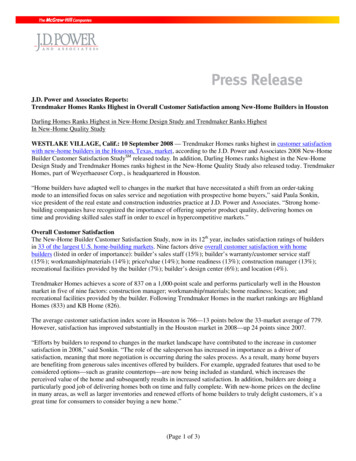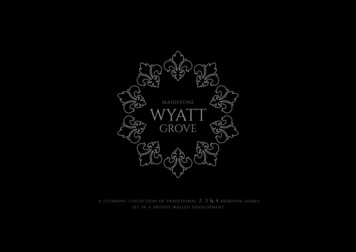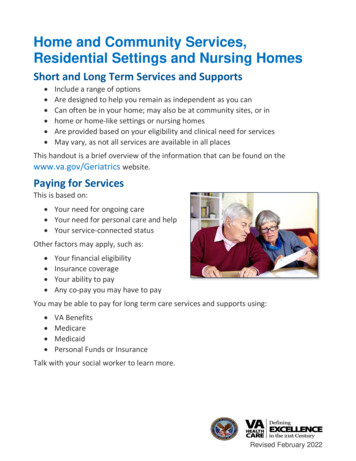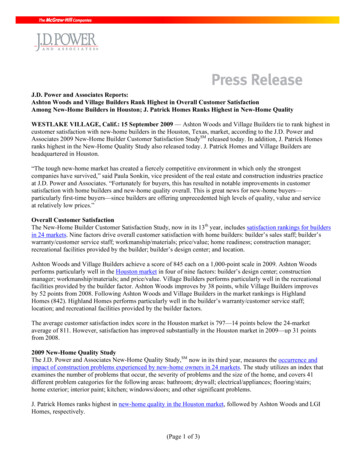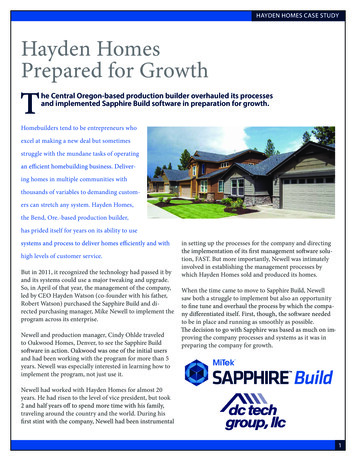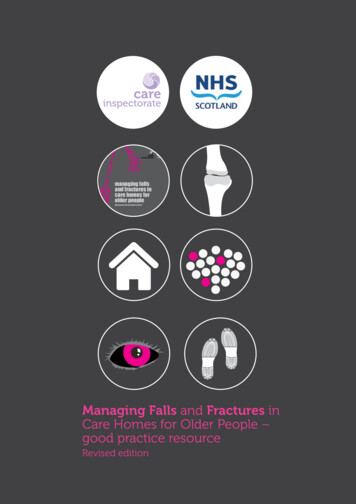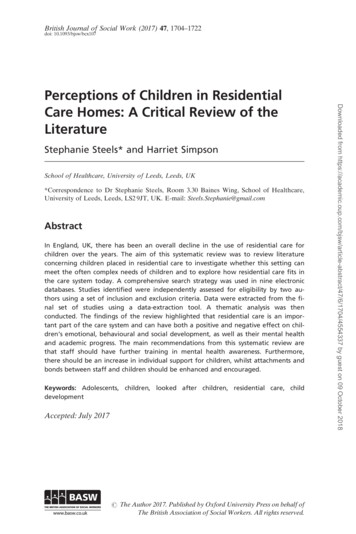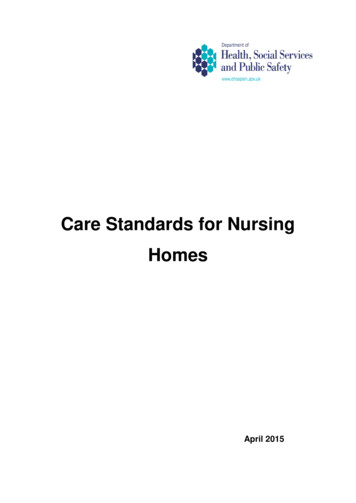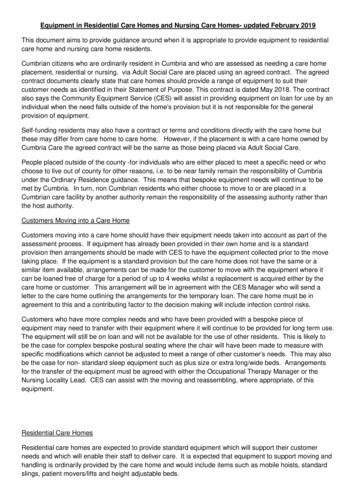
Transcription
Equipment in Residential Care Homes and Nursing Care Homes- updated February 2019This document aims to provide guidance around when it is appropriate to provide equipment to residentialcare home and nursing care home residents.Cumbrian citizens who are ordinarily resident in Cumbria and who are assessed as needing a care homeplacement, residential or nursing, via Adult Social Care are placed using an agreed contract. The agreedcontract documents clearly state that care homes should provide a range of equipment to suit theircustomer needs as identified in their Statement of Purpose. This contract is dated May 2018. The contractalso says the Community Equipment Service (CES) will assist in providing equipment on loan for use by anindividual when the need falls outside of the home’s provision but it is not responsible for the generalprovision of equipment.Self-funding residents may also have a contract or terms and conditions directly with the care home butthese may differ from care home to care home. However, if the placement is with a care home owned byCumbria Care the agreed contract will be the same as those being placed via Adult Social Care.People placed outside of the county -for individuals who are either placed to meet a specific need or whochoose to live out of county for other reasons, i.e. to be near family remain the responsibility of Cumbriaunder the Ordinary Residence guidance. This means that bespoke equipment needs will continue to bemet by Cumbria. In turn, non Cumbrian residents who either choose to move to or are placed in aCumbrian care facility by another authority remain the responsibility of the assessing authority rather thanthe host authority.Customers Moving into a Care HomeCustomers moving into a care home should have their equipment needs taken into account as part of theassessment process. If equipment has already been provided in their own home and is a standardprovision then arrangements should be made with CES to have the equipment collected prior to the movetaking place. If the equipment is a standard provision but the care home does not have the same or asimilar item available, arrangements can be made for the customer to move with the equipment where itcan be loaned free of charge for a period of up to 4 weeks whilst a replacement is acquired either by thecare home or customer. This arrangement will be in agreement with the CES Manager who will send aletter to the care home outlining the arrangements for the temporary loan. The care home must be inagreement to this and a contributing factor to the decision making will include infection control risks.Customers who have more complex needs and who have been provided with a bespoke piece ofequipment may need to transfer with their equipment where it will continue to be provided for long term use.The equipment will still be on loan and will not be available for the use of other residents. This is likely tobe the case for complex bespoke postural seating where the chair will have been made to measure withspecific modifications which cannot be adjusted to meet a range of other customer’s needs. This may alsobe the case for non- standard sleep equipment such as plus size or extra long/wide beds. Arrangementsfor the transfer of the equipment must be agreed with either the Occupational Therapy Manager or theNursing Locality Lead. CES can assist with the moving and reassembling, where appropriate, of thisequipment.Residential Care HomesResidential care homes are expected to provide standard equipment which will support their customerneeds and which will enable their staff to deliver care. It is expected that equipment to support moving andhandling is ordinarily provided by the care home and would include items such as mobile hoists, standardslings, patient movers/lifts and height adjustable beds.
Equipment to support the management of pressure care such as mattress overlays, high risk replacementmattresses and dynamic (airflow) mattresses and equipment to specifically support the delivery of nursingtasks will ordinarily be provided via the District Nursing team. If nursing intervention ceases thenarrangements must be made via CES for the equipment to be returned. Alongside this a step up, stepdown approach should be adopted wherever possible to support the appropriate level of pressure caremanagement. When a customer’s needs improve it is not unreasonable to expect equipment, particularlydynamic pressure care items, to be exchanged for a mattress with a lower specification.Assessments for the provision of equipment will continue to be supported by the relevant OccupationalTherapy/Nursing professional.Further details of equipment provision responsibilities are detailed in the table at the end of this document.Nursing Care HomesNursing care homes are also expected to provide equipment as outlined in the Residential Care Homesresponsibilities as above.In addition nursing care homes are expected to provide equipment to support the management of pressurecare such as mattress overlays, high risk replacement mattresses and dynamic (airflow) mattresses andequipment to specifically support the delivery of nursing tasks.There may be exceptional circumstances where the provision of some equipment would prevent the needfor a transfer to another care provision, prevent an admission to hospital or would facilitate a more timelydischarge from hospital. In these cases CES may be able to provide equipment however, this would bedealt with on a case by case basis in discussion with the relevant Occupational Therapist or NursingLocality Lead and the CES Lead Manager.Assessments for the provision of equipment will continue to be supported by the relevant OccupationalTherapist/Nursing professional.Further details of equipment provision responsibilities are detailed in the table at the end of this document.Respite CareCustomer’s equipment needs should form part of the respite care assessment and ordinarily the customerwill be placed in/advised to use a respite facility that can support all of their needs including equipmentrequirements.If the customer is already in receipt of loan equipment in their usual place of residence it cannot beautomatically assumed that the equipment will be provided in the respite care placement and this should beconsidered carefully. If there is an identified need to transfer temporarily with the equipment this should beagreed with the relevant OT/Nursing Locality Lead and the CES Lea/Service Manager. In these cases,where possible, arrangements will be made for a replacement item to be provided directly from CES tosupport infection control and to minimise disruption to the CES service. If the equipment is bespoke and noalternative is available through CES, arrangements must be made to facilitate the collection and delivery tothe care home and subsequent collection and return to the customer home in advance of thecommencement of the respite placement.Equipment will normally be available from CES to support crisis management however this will be dealtwith on a case by case basis in discussion with the CES Lead Manager.Visitors/Temporary ResidentsThere are occasions when visitors to Cumbria may require an urgent residential placement. These shouldbe dealt with as detailed in the Respite Care section.Equipment Review
It is important for prescribers to ensure that equipment in care homes is reviewed on a regular basis toensure equipment is relevant and continues to meet the assessed need. It is also important to preventhomes from swapping equipment to other customers, particularly in the instances where an existingcustomer has died or left the home. Every customer who has been issued with equipment, (that has beenissued by an Occupational Therapist or Nurse), should remain an active case and should continue to havea care manager assigned to undertake the review on a regular basis.As detailed above a step up, step down approach should be adopted wherever possible to ensurecustomers are provided with equipment that meets their needs, that promotes independence and, whereappropriate, reduces reliance.Equipment in Residential and Nursing HomesThis document sets out the Council’s and NHS Cumbria’s requirements in relation to the provision ofequipment within care homes in Cumbria and is based on guidance from The Department of Healthdocument integrating community equipment services -‘Community Equipment & Care Homes October2004.’A5.1Identifying Residents Equipment Requirements ssessmentA5.2.1The Provider shall ensure that the equipment is fit for purpose, and meets the Resident’sneedsA5.2.2A5.3Prior to becoming a Resident in the Home the “Placing Practitioner” (ASC Practitioner orHealth professional) is responsible for ensuring that an Assessment is completedidentifying the Resident’s equipment requirements.Where a prospective Resident is unknown to ASC and/or Health (e.g. private/self funded)the Provider shall request an Assessment from the relevant practitioner/professional.The Provider shall ensure that a Resident has access to the appropriate equipmentidentified in the Assessment to meet their individual requirements prior to entering theHome.The Ordinary Residence rules apply, see The Care Act 2014Where further advice/support is required the Provider shall request a review orreassessment of a Resident’s equipment as follows:a) At least annually if equipment has been provided through CES and is currently inuse, andb) if a Resident’s equipment requirements have changed in relation to the originalAssessment.Risk ManagementA5.3.1The Provider is responsible for managing the risk to Residents and Staff in the use ofequipment. The Provider shall manage equipment risks based on:a)the requirements of Health and Safety at Work legislation.b)information from the equipment supplier, andc)from the Medicines and Healthcare Products Regulatory Agency (MHRA)A5.3.2The Provider shall ensure that all Residents have access to the appropriate equipment tomeet their individual requirements.
A5.4A5.3.3The Provider shall ensure that all equipment is used in accordance with manufacturerinstructions and Staff involved in supporting Residents in the use of their equipment havereceived appropriate training/technical instruction and are able to support the Residentsafely prior to using the equipment.A5.3.4The Provider shall ensure that Residents receive appropriate training/instruction in theuse of equipment that they are using.A5.3.5The Provider shall keep a record of any instruction received and delivered in relation tothe above requirements.Provision of EquipmentA5.4.1General Provision - In accordance with The Department of Health Guidance and to meeta Resident’s requirements the Provider shall provide equipment of the type that wouldusually be required by the Home as part of its registered service and general provisionStatement of Purpose relating to its CQC Registration.A5.4.2The Community Equipment Service (CES) is a jointly commissioned service by ASC andNHS Cumbria to provide (loan) equipment into the community including care homes andnursing homes in Cumbria. The table in clause A5.7 Equipment types identifies items ofequipment that may be obtained via CES depending upon whether the Provider isdelivering a residential service (Residential Home) or a residential with nursing service(Nursing Home.)A5.4.3Equipment will not be provided by CES if ASC or NHS Cumbria considers that it isstandard equipment for the registered service. However, in the circumstances where aProvider is unable to provide items of equipment for which it is responsible, it may beloaned, on an exceptional basis, through CES. NB. Loans will be free of charge for aperiod up to 4 weeks, on the fifth week the Provider will be invoiced for 100% cost of theitem as new and will receive a 50% credit on return of the item to CES.Residents equipment needs will be assessed on an individual basis in accordance with the Care Act2014. Any equipment recommended or provided should be used in conjunction with the resident’s careplanA5.5Accessing equipment via CESA5.5.1Where an Assessment identifies the need for non-standard/specialist equipment thePlacing Practitioner will:a)b)c)d)A5.5.2arrange the loaned provision from CES to the Providerconfirm loan period i.e. long term or short term (1-3 months)demonstrate safe use of equipment to the Provider’s nominated Staff for cascadetraining to other relevant staffmake arrangements for the equipment to be maintained and serviced wherenecessary.The Provider shall:a)Clarify ownership and arrangements for equipment when a Resident is firstadmitted to the Home.b)Clarify arrangements for returning equipment when it is no longer requiredby the Resident.c)be responsible for all charges associated with relocation of equipmentwithin the Home in the event that a Resident is transferred to an alternativeroom.
d)Identify when equipment is no longer required and release it promptly forcollection.e)Inform the Adult Social Care Practitioner or Health Professional of changesin Residents’ needs.f)Inform the CES service promptly in the event of need for maintenance,replacement or breakdown of CES equipment.g)Notify relevant parties of changes in Resident accommodationarrangements for whom equipment has been loaned (e.g. hospitalisation,movement to another Home.)h)meet the cost of all repairs arising from negligence, damage, orinappropriate use and the cost of replacement if it is lost. (All repairs andmaintenance of loaned equipment will be co-ordinated and carried out byCES through the relevant contractor.)i)ensure equipment is kept in a clean condition and be responsible for theday to day operational cleaning/disinfection of equipment in accordancewith manufacturer or supplier instructions.j)A5.5.3A5.5.4A5.6Equipment ClarificationA5.6.1A5.6.2A5.7ensure that any equipment provided on loan from CES is prescribed for thesole use of the named Resident.The Provider shall not permit the use of this equipment for any other Resident.Where bespoke slings are provided for an individual resident they will be gifted to thehome for that person’s exclusive use. The responsibility of the LOLER and PUWERcompliance will be transferred to the home.Equipment is divided into standard and non-standard groups and clarified as follows.Standard equipmenta)Is readily available from a range of suppliers as an “off the shelf” purchaseb)Can be used to meet a range of Residents’ needsc)Could be adaptable and flexibled)Meets general health & safety requirements, personal care needs etc.e)May support independenceA5.6.3Standard Equipment shall be supplied by the Provider as part of the Home’s provision fortheir registered service user group(s). On a case by case basis and subject to individualassessment standard equipment may, be loaned via CES for specific individuals.A5.6.4Non-standard equipmenta)Might be specifically tailored in respect of design, size, weight e.g.designed or adapted or bio-engineered and manufactured for a specificindividual and/orb)May not be capable of being utilised by other Residents and/orc)Could be frequently or infrequently used by the Resident and/ord)Support a specific solution for a particular long term disability ormedical/nursing problem and/ore)May require enhanced training to operate and clinically use, or to teachothers to operatef)May be loaned/issued via CES on a case by case basis when identifiedas necessary and appropriate to meet a Resident’s assessed needs.Responsibility for Equipment ProvisionA5.7.1The Provider shall have sufficient number of hoists and slings to meet the needs of theResidents in the Home.
Further advice can be obtained from Adult Social Care Practitioner or Health professionalA5.7.2 The respective responsibilities of all parties for the provision of equipment in Cumbria areset out below. The Provider shall be responsible for the provision of all items ofequipment identified “PROVIDER” in the table below depending upon whether theProvider is delivering a residential service (Residential Home) or a residential with nursingservice (Nursing Home.)Key:Provider - the Provider is responsible for provisionCES Community Equipment Service (loaned via ASC or NHS staff)NHS Health professional will provideDSC provided by the wheelchair provider (Disablement Services Centre)Items of EquipmentNursing HomeResidential HomeFor administration of rectal medication e.g.glovesFor administration of medication by injectionPROVIDERPROVIDERPROVIDERNHSSyringe DriversPROVIDERNHSRange of bath seatsRange of bath boardsElectric /manual bath liftRange of shower PROVIDERPROVIDERPROVIDERGeneral beds under risk managementBedsPROVIDERPROVIDER4 section height adjustable communityprofiling bed .To support community nursing/occupationaltherapy interventionStandard height adjustable beds to enablesafer delivery of personal care and manualhandling tasks.Non-standard beds for people with complextreatment and care needsPROVIDERCESPROVIDERPROVIDERCESCESBed levers/Assistive VIDERPROVIDERCESPROVIDERPROVIDERCESCESFor administration of medicineBathing EquipmentBed attachments for risk managementRange of back restsRange of bed raisersMattress elevators/variatorsLifting poleBed rails and bumpers for 4 section heightadjustable community profiling bed.To support community nursing/occupationaltherapy intervention
Items of EquipmentNursing HomeResidential HomeBed rails and bumpers for standard heightadjustable beds to enable safer delivery ofpersonal care and manual handling tasks.Chair raising equipmentPROVIDERPROVIDERChair raisersPROVIDERDressing equipment/Environmental supportPROVIDERStocking aidTights aidLong handled shoe hornHelping handPerching RHelp with feedingFeeding equipmentMobility EquipmentWalking equipment – provided on basis of assessmentMetal walking sticksNHSFischer walking sticksNHSMobility EquipmentWalking equipment – provided on basis of assessmentNHSNHSWalking framesWalking frames gutterMetal Crutches axilla metal(special criteria , special order)Crutches metal elbowWalking frame with front wheelsHeavy –duty / Bariatric mobility equipmentspecial orderMobility equipment – ndard transit chairs, & wheelchaircushions for communal useSelf propelling wheelchair prescribed for theindividual user, or transit chair to be used byfamily (kept at family member’s homeaddress NOT at residential/nursing home)only, on an almost daily basis.Nursing equipmentPROVIDERPROVIDERDSCDSCSyringes and needlesVacutaine bottles for blood testsPatient RepositioningPROVIDERPROVIDERNHSNHSFor lifting and manual handling under Healthand Safety at Work Act, e.g. hoists, slings,transfer boards, glide sheetsStandard SlingsPROVIDERPROVIDERPROVIDERPROVIDER
Items of EquipmentNursing HomeResidential HomeBespoke SlingsCESStanding turntable e.g. RotastandPROVIDERPrevention therapy and prevention pressure soresMattresses StaticCESPROVIDERStatic foam replacement mattressmedium/high riskMattresses DynamicAlternating pressure overlayAlternating pressure mattress ESStatic foam/Gel for medium /high risk andtreatmentRespirationPROVIDERCESsuction unitsStandard nebulisersPulse oximetersResuscitation equipmente.g. ambu bags and NHSPROVIDERRange of standard chairsA variety of chairs shall be provided by theProvider that meet the needs of its Residentsas described in its Statement of Purpose andas set out in the Provider’s CQC registrationunder regulated activities, service types andservice user bandsNon- customised riser/reclinersNon- customised tilt-in-space chairsi.e. seating with adjustable adaptablefeaturesComplex, bespoke seatingBespoke ERPROVIDERCESCESCESCESCESCESBed pan /slipper panCommodes standardCommodes-mobile.Toilet seats 2”, 4”, 6”Toilet framesToilet frames and seat combinedCommodes – non standard e.g. removablearms for lateral transfersCommodes – DERPROVIDERPROVIDERCESCES*these items are only available as hip and knee precautions following joint replacementSurgery and are prescribed by Health professionalsA5.8Respite care arrangementsA5.8.1The Provider shall ensure that all respite care arrangements shall take into account theneeds of the Residents and suitable equipment shall be available within the Home when
arrangements are made. CES will not provide any service to meet respite carearrangement except in exceptional circumstances. Separate arrangements may berequired to ensure H&S provision is met in residential homes to support district nursingstaff to deliver nursing care. This will be considered on an individual basisA6Relocation of beds and associated equipment to another room within the same care home .A5.8.2Where this is requested it is likely to incur a charge from CES
Residential Care Homes Residential care homes are expected to provide standard equipment which will support their customer needs and which will enable their staff to deliver care. It is expected that equipment to support moving and handling is ordinarily provided by the care home and would include items such as mobile hoists, standard
